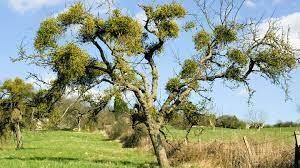As we enter the autumn and winter months, and wave goodbye to the summer, there is still much to look forward to from the natural world. Although most of the flowers and trees have died back at this time of the year, bedding down for the long, dark winter months by preserving their life force in their roots, there are plants that are in bloom over these cold and frosty months – and one of the most famous and beloved of all is mistletoe.
Mistletoe is a festive staple that is brought into the house around Christmas time in order to bring joy and cheer – and of course, boughs of mistletoe are hung for lovers to kiss under. The love of mistletoe at this time of the year goes back to the ancient Druids and Celts who inhabited the British Isle thousands of years ago. The white berries of the mistletoe were said to represent fertility, hence the tradition of kissing underneath it.
Where mistletoe was found growing was also something that was important to the druids. The English oak is one of the best loved trees in Britain, an iconic sight to see in the woodlands and fields, as well as being loved by builders for things like these Oak Framed Extensions https://www.timberpride.co.uk/timber-oak-framed-extension/ – but going back to the times of the druids, the oak tree was also a magical and powerful tree, seen as the door to the other world and a symbol of strength. Therefore, mistletoe that was found growing in the branches of an oak tree was considered to be the most powerful of all – as long as you didn’t let it touch the ground when you collected it, as all of the good fortune was believed to drop out of it when it did so.
If you are planning to go and find some mistletoe to bring into your home this year, the best place to look is in apple trees. Poplar is also a favourite tree for mistletoe, but it is actually quite rare to find it growing on an oak. It is best to look in open areas of land such as hedgerows, fields and even churchyards, as it is not something that is often found in woodland.
When you are foraging, be mindful that mistletoe is important to the native wildlife so don’t take too much. It is good to read responsible foraging guidelines. The mistletoe marble moth relies on this plant, and it is a food for the birds at a time when food is scarce. In fact, it is important that the birds do eat the berries as this is how mistletoe is spread.
When the birds eat the berries, they leave the seed – and wipe their beaks on the trees to get rid of the stick substance. This then helps the mistletoe to set up home on a new tree, and the cycle can begin once again!





